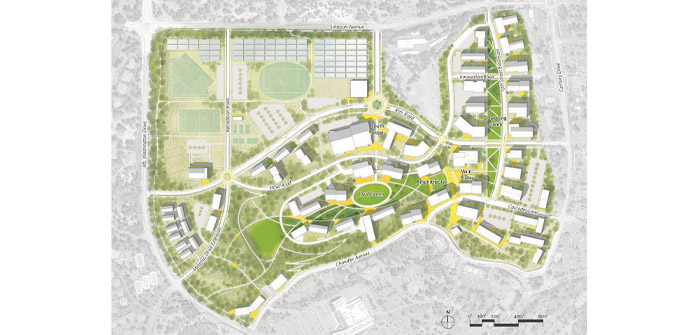(Illustrative Plan of the Oregon State University – Cascades campus | Rendering courtesy of OSU-Cascades)
Hailed as “one of the most innovative university development projects in the country,” 118 acres of OSU-Cascades properties — previously occupied by a pumice mine and a Deschutes County construction and demolition landfill — are being transformed over the coming three decades into a 128-acre campus serving up to 5,000 students.
Guided by OSU-Cascades’ Long Range Development Plan, the long-term expansion project includes 13 new buildings, roads, sidewalks, parking, athletic fields, a pedestrian bike path, green spaces on Bend’s west side, and — with construction now underway — a 17,500-square-foot Student Success Center.
Operations and construction of the full campus development — and the economic ripple effect they create — are estimated to bring more than $273.7 million to Oregon in 2034.
As Jarrod Penttila, OSU-Cascades’ associate director for capital planning and construction manager, explained, “The total project cost of the Student Success Center is $21.75 million. The funding includes $13.8 million from the state, $2.8 million from OSU, and $5 million that is being contributed by the students themselves — who voted in 2017 to increase their student fees for the additional space and enhanced success services.”
Penttila, who comes from the high-tech sector, admitted that one of his greatest challenges is “to do all this work with the next 100 years in mind.”
For example, he said, “after closing out the pumice mine and removing hazards from the landfill back in 2018, the challenge was looking at a giant hole and a couple of big hills — and envisioning such objectives as creating nice views from the right spots, disciplined thoroughfares, setting up the elevations of the roadways to have universal accessibility, balancing how we get stormwater to move through the campus with adjustments in elevation, and deciding where to put utilities to ensure that they are useful both now and in future decades.”
A primary goal of the expansion project is “environmental sustainability,” according to Penttila. “We’re creating a net-zero campus — which means OSU-Cascades consumes only as much energy as it produces, balances water availability and demand, and eliminates waste sent to landfills.”
Penttila, who is able to see the proverbial trees as well as the forest, regularly has gratifying moments resulting from his efforts — such as observing someone with a stroller enjoying the newly created walking paths. “To see something like this through is a dream job,” he said.
Student Success Center Intended to ‘Expand Collaborative Opportunities’
Recognizing that classes are only one element when it comes to earning a degree and subsequently becoming an engaged and active employee, OSU-Cascades has initiated construction of the Student Success Center in “a key core location on the campus,” said Nathan Moses, interim associate dean of student life.
Although “not quite a one-stop shop,” to use his words, the 17,500-square-foot facility will provide services such as academic and career advising, mental health and financial aid counseling, and disability access. It will also have spaces for study and tutoring, an equity lounge, arts presentations, meeting rooms and gathering areas, with access to recreational programs, student organizations, and a food pantry.
“Around the country, 55 percent of first-time freshmen enroll at a college within 50 miles of home,” said Moses, “with Central Oregonians representing 42 percent of students at OSU-Cascades. Without a nearby university, some young people may never attend college. But when they do, student success services can make a difference. This is especially critical for under-represented, first-generation, low-income and rural students.”
The Student Success Center will also support an ongoing need for campus facilities and services to keep pace with student enrollment. According to a study by the Oregon Higher Education Coordinating Commission, OSU-Cascades led enrollment growth at Oregon’s public universities in 2020 with a 27 percent increase in first-year students and a 16 percent increase in transfer students — yet lacked student support space.
“Because this is a student-focused building, we were very intentional in gathering student input throughout the design process,” said Jarrod Penttila. “We set up a lot of interactive feedback sessions; showed renderings; asked how to make the space more comfortable and inviting; and did a survey of students — including minority and disadvantaged — to gather individual feedback. Choosing the type and size of art to make all students feel included was just one example.”
The Student Success Center — in centralizing all the services that are currently in separate buildings — “is intended to engage students quicker. It will be hard for them to walk by one resource without seeing others,” said Moses.” And the informal gathering spaces will give students the opportunity “to blow off steam, and make emotional connections,” Penttila added. As the two men summarized, “The building has been specifically designed to expand collaborative opportunities, so students can thrive and support each other.”
Gathering Support for 128-Acre ‘Community Asset’
“Establishing a university campus in Bend had been a 30-year grassroots effort,” explained Nathan Moses, who served as community outreach coordinator for OSU-Cascades earlier in his career. “But it still marked a change for the community, and that’s why our engagement plan involved input from hundreds of community members over several years — including those who had concerns.”
Starting at the ground level, “the planning effort focused on how the campus could serve the educational and economic needs of the region, while upholding the area’s beauty, and increasing OSU’s integration with the community,” Moses said. “The word I often used was ‘permeability,’”
“We’re building a campus that we hope will become a community asset long into the future,” he would explain.
As the project develops, it will incorporate more sidewalks, roads, parking, and green spaces into the campus. OSU has, and will, contribute to off-campus infrastructure to support the growth, such as the recently opened roundabout on Colorado Avenue to help with traffic, and a future pedestrian bike path, leading to one of the campus’s to-be-built entrances.
“In addition,” said Moses, “OSU-Cascade students are becoming involved in community projects such as volunteering at Think Wild (a wildlife rescue organization) in honor of the Martin Luther King Jr. Day of Service. The more students are engaged, the greater benefit they provide. So both the campus and the community are supporting each other.”
Long after the early days of his outreach efforts, Moses talked to a community member who was initially concerned about the campus expansion. “He told me that ‘now I understand what you’re doing. And the way you’re doing it will help to stabilize the area during down periods, and make OSU-Cascades an asset.’”
“The opportunity to build a new college campus doesn’t come around very often,” he said, “We take this very, very seriously.”





